

Sponsored by Peter Vaughan,
East Anglian
Cyclemotor Club
- Devon member
We lie in the soft earth looking helplessly up at the last sparkling shards of the wormhole closing above us in the sky. Wherever we are, there is no going back that way!
Standing up and brushing ourselves off, we find we are in a field adjacent to a track, which takes us down towards a town at the bottom of a river valley. Along the way, we are passed several times by trade carrier bicycles, the riders enthusiastically ringing their bells to warn of their approach.
Nearing the town, the hillside affords a clear view across all the buildings and streets. We see no cars, only pedestrians and cyclists, and without exception—every cycle is a trade carrier!
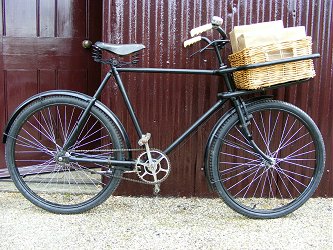
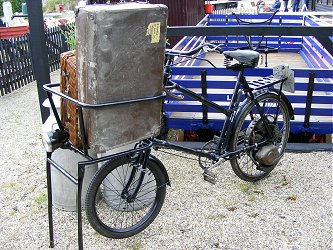
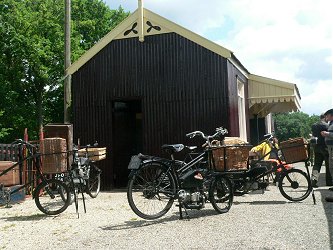
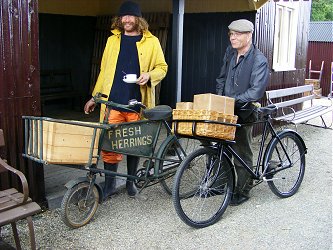
Carrier bicycles everywhere
The scene is clearly not our present day, and reminds us of the 1930s, so not only have we fallen back in time, but we would also appear to have slipped sideways into some strange alternate, trade carrier dimension!
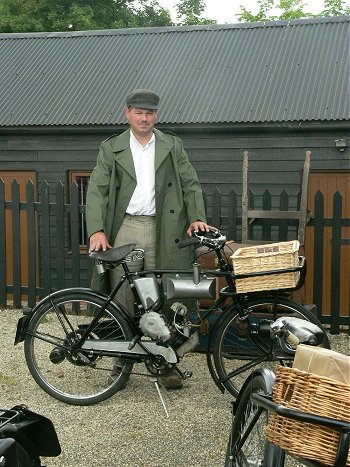
Levis/Hercules carrier autocycle
We sit on a wall to study the scene for a while, and observe that several of the busy trade carriers are not being pedalled at all, and leave a trail of smoke. This can only mean that they must be motorised! Intrigued, we wander into the town to take a closer look. In some ways, carrier machines make a lot of sense, since you always have somewhere to put anything you may wish to transport, and though rather cumbersome, they are certainly very practical—so why have anything else?
Back in our world, motorised trade carriers are very few and far between, many people may hardly have even seen a picture of one, but in today’s superfeature—we test three of them! And what a stunning trio they are, all appearing to be ‘ancient autocycles’, dating from the pre-war or war-time era. Over the decades, two have become parted from any original registration, so losing all connection with any historical provenance. Now all we can do is look at the machinery in front of us to work out what we can about these respective vehicles.
Even where to begin is difficult, since all could originate around similar dates … OK, let’s start with the Levis engined thing! I say thing, since it’s obviously not an HEC Power Cycle, which was the only UK machine using the Levis autocycle engine—until this came along!
The HEC Power Cycle first appeared at the Earls Court Show late in 1938, made by the Hepburn Engineering Co of King’s Cross, London. The engine was an 80cc deflector top two-stroke of their own design, but manufactured for them by Levis. By spring of 1939, the business had relocated to Birmingham, and the engine received some modifications for 1940, which was the last year of production for the autocycle. Frame serialisation ended at number 885 when the Thorpe Street Works was bombed on 3rd May 1940, after which HEC merged with Levis and turned to making air compressors.
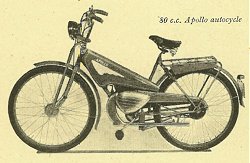
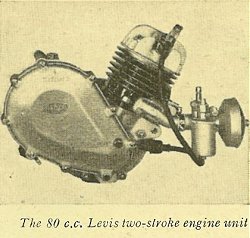
The 1951 Apollo autocycle
and its Levis engine
There were certainly a significant number of the Levis engines left over after manufacture of the Power Cycle concluded, and these were being offered up for sale for many years afterwards. Though the Levis autocycle motor never again found its way into any other British production built machines, some continental builders later seemed to have employed the engine in small quantities; announced as late as May 1951, the Swedish-built Apollo being one example.
Now the motor may look like it’ll drop straight into the crook of any cycle frame, but there’s an awful lot more to making up a practical working machine, so little ever really became of many of the spare Levis engines, and you still sometimes see them at jumbles today. Over 65 years old, and still looking for a home!
Possibly, our Levis engine was one of these leftovers, that sometime found its way to being installed into this contemporary Hercules Trade Cycle frame, dating from around the same pre-war/war-time period. One might even like to think that it was a war-time creation, born of the necessity for improvisation, but who knows? The ‘Levules’ was obviously a very special autocycle, seemingly built for trade operation, and almost certainly unique. The list of modifications to complete this installation would probably prove pretty daunting to most persons being inspired to have a go themselves. The lower and front mounting plates are welded to the frame, demanding a removable ‘L’ shaped frame section bolting into place between the crossbar and saddle tube to complete the engine’s three-point mounting within the ‘diamond’ frame.
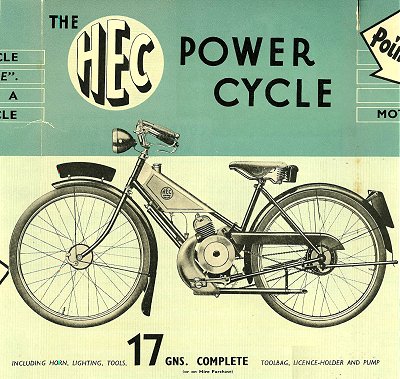
Detail from HEC Power Cycle brochure
Beyond the basic installation, there’s also an eye for practicality and styling, in shaping of the specially made petrol tank and toolbox to fit the frame. The drive chain return run would clearly have fouled the bottom stay, so a heavy-duty idler sprocket mounts from a substantial plate, bolting to the frame tube, inside the chainguard (its position is identified by a ‘cone form’ in the drive chainguard covering the spindle location point). The drive chainguard itself comprises only a simple fold, though the form is obviously sculpted to suit the frame. Over on the pedal side, a standard cycle chainguard is shaped to accommodate the motor, and the toolbox is even specially relieved to access the motor oil filler plug.
The accompanying cast alloy exhaust expansion chamber has been much modified and crafted to permit a tidy exhaust routing above the bottom bracket, so allowing the mounting of a cycle centre stand. The exhaust features an alloy pipe all the way to the rear axle, where it terminates in a diffuser pepperbox, anchored with a security chain.
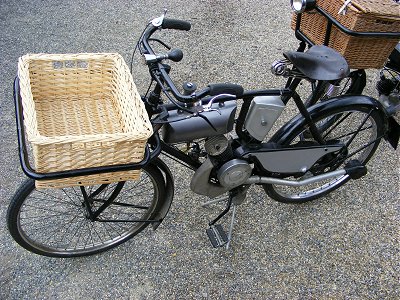
Levis/Hercules carrier autocycle
The pedal arms must also feature special forms to clear the engine, and the rear hub is a Perry Coaster, so Levules has three brakes! The two rod brake sets of the cycle frame, and the back-pedal bronze cone hub. Both wheels are standard 26" cycle size, so the carrier frame accommodates only the shallow capacity basket, and handling is expected to feature conventional characteristics.
Starting Levules begins with a trick! The petrol cap has a screw sealed vent feature on the top of the cap, so you have to loosen the knurled thimble to initiate fuel flow. Push on the petrol tap under the tank, and fuel runs down the line to the Amal carb. There’s a flood button on the float chamber top, and a strangler shutter, so the hardest winter shouldn’t concern this workhorse.
Since cycle centre stands aren’t particularly robust, and the Levis engine has no decompressor, it’s best recommended to pedal away up the road and drop in the clutch to get the engine spinning, turn up the throttle lever, then as the Levis burbles gently into life, pull back the clutch, and reach down to open the choke shutter. As the Levis clears its rich mixture, trim back the throttle lever and the motor strums gently away as it warms in the morning sun.
The flattened exhaust note is lazy and pleasantly relaxing. Then, as we pedal lightly away from the kerb, feed in the clutch, and tweak on the throttle lever, the exhaust beat smoothes to a mellow load tone. Levis sure knew how to make a nice engine!
Levules purrs steadily up to working speed, then levels out into a low drone as the gas scavenging of the deflector motor reaches optimum transfer—and that’s it, that’s what it does! Maximum speed hits between 22–25mph on the flat according to conditions, and maybe a little more downhill with the assistance of gravity, but the braking performance rather tends to encourage restraint under these conditions. Even at revs, the Levis continues to 2-stroke smoothly, and suffers no tendency towards unpleasant bouts of 4-stroking that could affect some contemporary stablemates.
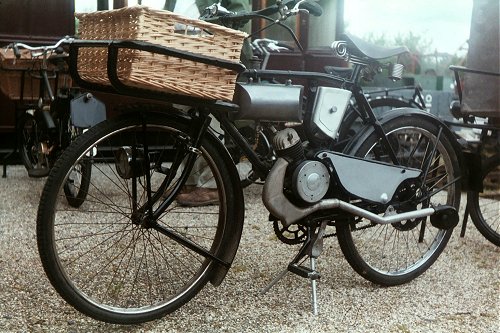
Levis/Hercules carrier autocycle
It’s probably just as well that the Levis engine doesn’t achieve any spectacular performance, as the cycle rod brake set is ‘challenged’ enough hauling Levules down from full steam. The back pedal Perry Coaster hub brake is pretty useless even in a normal bicycle—Levules just laughs at it, but having three ineffective braking systems is probably slightly better than having only two ineffective braking systems.
Normally, trade carrier autocycles had their headlamps mounted on the front of the carrier frame to clear the load and maybe comply with some long lost minimum height requirements for motorised vehicles, but being based upon a trade cycle frame, Levules still wears its headlamp on a sprung bracket low down on the right hand fork leg. This location hardly concerns the rider’s ability to see in the dark, since the lights are so dim that illumination of the road is only left to the imagination. The low obstructed mounting however, affects the machines chance of being seen by drivers of other vehicles at left hand junctions, so rider beware at night!
Levules is ideal for its purpose as a trade carrier autocycle, it starts easily, runs smoothly and confidently, and would carry moderate loads more quickly and efficiently over greater distances than any lad on a trade bicycle. It didn’t need to be fast, it’s relentless, it gets the job done, and that lovely Levis engine was just the tool for the task. Levules has fascinating detail and fantastic character, but is totally unique; what a shame there aren’t any more of them!
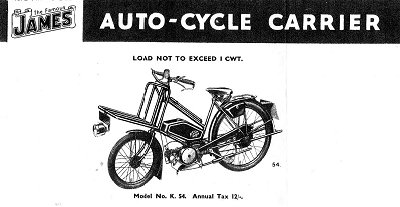
The James K54 Auto-Cycle Carrier first appeared in illustrations of 1939, accompanied by an interesting picture of a rather splendid James Samson K74 Auto-Tricycle Carrier! Both machines are pictured with the early Villiers Junior deflector motor, and while James were probably one of the later customers receiving the new de Luxe motor, their carrier machines were still likely to pre-date the Norman.
The illustration shows the Auto-cycle mounted with a ‘flat carrier’ platform, though these generally proved pretty unpopular to the trade due to the necessity to laboriously tie everything securely on, so the basket option was more likely to be favoured by customers.
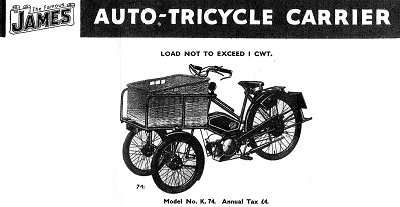
While it is established that James certainly listed and built fore-tricycles, no historical evidence survives to tell us about the manufacture of any Motorised Tri-Carriers or even any Carrier Autocycles before the war began to disrupt proceedings. In December 1940, the Luftwaffe bombed out the James factory destroying all records and concluding their brief dalliance with motorised carriers.
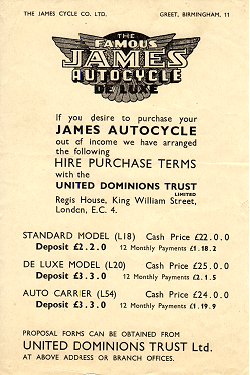
1940 James leaflet listing
the L54 Auto Carrier
No examples of the Auto-carrier had been previously known, so this machine is almost certainly unique, and though unable to explain this mythical beast, it surely stands proudly before us like some living legend! Bearing the James frame number J540 indicates it falls within the 1939 autocycle series, the fork stem correctly carries the stamp of Accles & Pollock as period tube supplier to The James Cycle Co, and the SH5784 Junior serial complements this dating. Rebuilt from little more than the remains of a bare frame with few surviving parts, and having no original registration mark with the machine, any provenance proves untraceable.
No half-measure, bolt-on basket for this particular James either—the carrier frame bosses are integral in the headstock lugs; with the tubular basket frame very firmly brazed in place, this monstrous chassis is certainly impressive! The small wheel trade carrier frame is uniquely different to any conventional James autocycle, and that characteristic, six-sided, coffin-shaped, extra-capacity commercial half-tank is like no other market model by any manufacturer. Probably about as long as they come, the enormous 48" wheelbase frame is equipped with two cycle stands, the traditional rear stand for normal use, and the front trade carrier stand for stability while loading and unloading. While the sprung front stand proves very stable and easy to use, the rear stand is awkward to operate with its screw security clip. It offers little practicality since you can’t even detach the back wheel to repair a puncture without removing the stand first, and it’s certainly going to be tempting fate in trying to use the rear stand while grappling with any serious load in the forward basket.
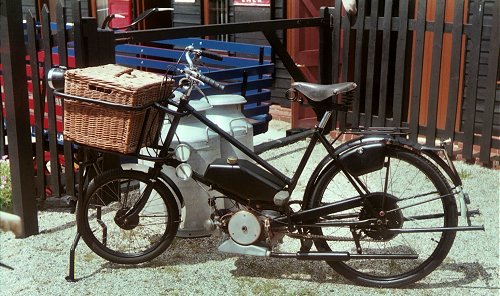
James K54 Auto-cycle Carrier
James is neatly styled and generously appointed for a commercial model, with fitted toolbox mounted off an industrial gauge stay set, a full length tailpipe silencer, and probably appears the tidiest and most purposeful example of our trio, neat and cleanly designed for doing the business.
Starting could be like any conventional autocycle on the rear stand, or by flying start down the road for those urgent deliveries. Favouring the static option with a brute like this, usual Villiers practice, shutter choke (no need to flood), clutch out, decompressor—spin & release, tweak up the throttle lever, and Junior fires up easily first time. Probably explained by the larger 7/8" diameter ‘commercial’ tailpipe set, the exhaust note is a little deeper than the expected crisp pop from James ‘domestic’ models with their weedy 3/4" pipes.
Pull on the back brake to stop the back wheel spinning, push off the rear stand and the noticeable drop in revs indicates the clutch is slightly dragging, but pull the lever up to the bar and it’s fine, so appears more like the straight lever that’s fitted isn’t giving the desired range on the latch. Holding in the clutch lever we clip up the stand and tighten the security wingnut. The saddle is set rather high, so feels a little uncomfortable.
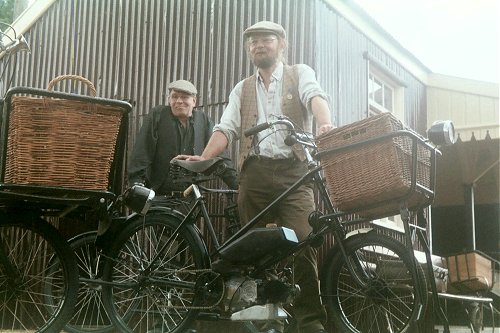
James K54 Auto-cycle Carrier
Thumb open the throttle lever, a light pedal assistance while feeding out the clutch, and we gargle away down the road. Initial impressions are not confidence inspiring! The metal framework stretches way out ahead, and without the basket fitted for the test run, it’s apparent the front wheel is out of true. Slow for the end of the road, and though we’re only travelling relatively sedately, it’s apparent that the relined brakes haven’t bedded in yet. Cruise away from the junction, and though the motor feels to be pulling strongly enough, within a short distance down the road it’s misfiring and 4-stroking quite badly. The condition fails to clear even when the engine is fully warmed up, and the Auto-carrier struggles to make 20mph on the flat, and best 29mph downhill. The motor clearly had a lot more to give, but was being held back by the state of carburetion tune or some ignition malady.
Due to the editorial deadline, we don’t have the luxury of time to investigate the cause of the malady on this occasion. It’s clear the Auto-carrier has a little more development before it’s fully operational, but the restoration is steadily getting there.
Probably helped by the long wheelbase geometry, the handling didn’t feel to become any more unstable at speed, though one dreads to think what it might be like with a load aboard. There was a lot of road surface feedback through the short rigid forks, and timely braking would really have benefited from the assistance of long-range radar!
The James Auto-carrier is certainly a stunning machine, all the metalwork and sheer size of the brute are most impressive, and its lines from certain angles are quite captivating—but would anyone in their right frame of mind want to do 1 hundredweight trade deliveries on one, as they specify in the sales leaflet?
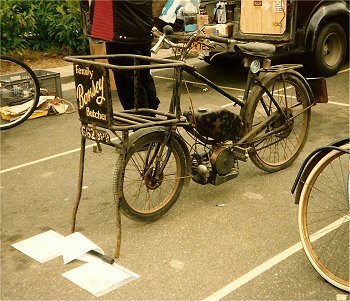
The Bonsey Butchers carrier in 1990
The Norman Trade Carrier Autocycle first appeared in factory brochures of late 1939, and listed into 1940 until the Norman plant closed down in Autumn of that year, for the rest of the duration. Only illustrated with the Junior de Luxe engine, which didn’t become available to Villiers customers until the later half of 1939, we must conclude the first model probably wasn’t created until after the earlier Junior deflector motor had been succeeded, therefore the Norman would appear the latest dated machine in our trade carrier trio.
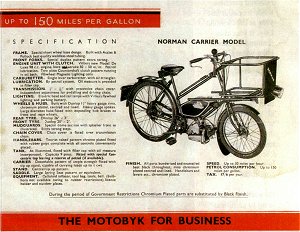
Norman Trade Carrier Autocycle
brochure
The period brochure is liberally marked with conditional amendments, so wartime restrictions were certainly applicable at the time it was issued. The likelihood is that the Norman Carrier was prepared for release at the November 1939 Earls Court Show. Machines would very probably only have been intended as built-to-order, so very few examples would have been sold at this time.
Surviving examples are obviously immensely rare, however, a 1939 model, originally one of a pair operated by Bonsey Butchers of Gerrards Cross, attended and was pictured at The East Anglian Run back in 1990. Our wonderful test machine has its own remarkable provenance known. It differs in detail from the ‘Bonsey’ machines, in its single blade fork set, rear carrier, and mudguard arrangement, so is concluded to be a 1940 model.
Germany surrendered on 4th May, and Japan on 2nd September 1945, in between which, this Norman Trade Carrier Autocycle, frame number 4906, was supplied by Eversheds and registered on 23rd July 1945 to Hawkes & Sons, Grocers of Bognor Regis, West Sussex.
Accompanied by old tax discs up to 1965, it had a long and hard working life, kept going by ‘make and mend’ repair using identifiable parts from some salvaged Francis Barnett Powerbike 50. The characteristic back pedal braking mechanism, twin barrel exhaust and later engine batch serial are unmistakenly adapted from this source. Presumably left to decay for another 40 years, this trade carrier’s dismantled and shockingly rotted remains were finally recovered in January of 2006—and just 8 weeks later, it’s rebuilt, back on the road, and registered with its original re-issued number. On its debut outing, our Norman showed it was no plodding donkey, provided the pilot is brave enough! Despite the inherent disadvantage of its unsporting frame design and high drag dynamics, it stonks around the 36 mile course of the third Radar Run (2006) among the front running group, easily holding its own with the best of any other autocycles.

Norman carrier on
an EACC road run
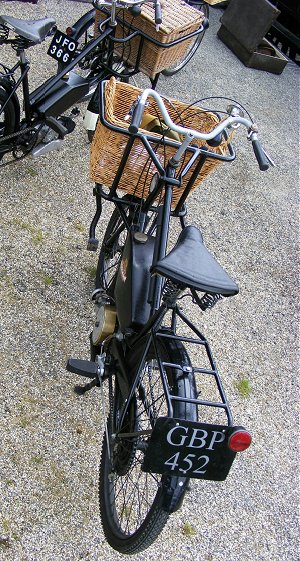
Restored with the Francis Barnett adaptations still in place, since they form part of its history, the twin barrel exhaust seems to suit its cluttered commercial appearance, while the back pedal brake system usually functions with better leverage than a hand lever and simplifies control operation at the left handlebar. Front braking ability should benefit from the laws of physics associated with a small 20" front wheel, so we are hopeful to expect the novel situation of an antique autocycle with brakes that might actually stop!
Compared to a normal autocycle, there’s just too many individual differences to go into specific detail, but the Norman Trade Carrier is simply a visual feast of pre-historic functionality. Looking at this is guaranteed to put a smile on your face…
Anyone who’s ridden a loaded deep-carrier trade bicycle, and lumbered it up to speed with energetic pedalling action inducing veering motions, would probably approach any such motorised version with some trepidation. The stubby 43-inch wheelbase and higher speed potential conjure fearsome visions! Fear ye indeed! Though motorization dispels the ‘oscillation’ issue that develops from pedalling action, Norman’s handling reportedly ranges from nervously twitchy on smooth surfaces, to alarmingly unpredictable on bumpy bends. The recommendation is to avoid signalling completely and keep both hands firmly on the handlebars at all times … anyone fancy a job as test pilot?
It’s certainly an unfamiliar view as the pilot of an autocycle to be looking down at all the forward ironwork on these carrier machines, and with some hint of apprehension as the prospect of any mishap becomes more intimidating when appreciating that the legs of the folded up forward stand are pointed directly back at the riders shins!
The Norman is equipped with two cycle stands, the conventional centre stand for normal use, and the trade carrier stand for better stability when dealing with a load. Starting is standard autocycle practice. Turn on the fuel from Norman’s own, generous capacity half-tank, choke shutter operated by rod linkage on the left hand side, lever throttle, decompressor, a couple of firm kicks on the pedal, and as Junior de Luxe chugs into life, we reach forward to open the choke shutter—only to feel the motor fade straight away. It’s another of these reluctant old warhorses that wants a good running up before it’ll entertain being ridden—certainly no flying starts with this bike! Once we get under way, tweaking back the throttle gives a strong, torquey response with a deep roaring exhaust tone that so suits this commercial machine. It really does sound the part with that short 1 inch diameter outlet pipe on the F-B twin barrel system.
As the motor warms up to speed, we find that the NTC is most comfortable cruising up to a little over 20mph, after which increasing vibrations come in the faster you go, making riding at speed particularly fatiguing. Typically, the Carrier holds 28mph to 29mph on the flat, up to best paced 31mph with a tail wind.
The rider naturally assumes an upright posture with the pull-back handlebars, and considering the quirky handling, any attempt at a ‘sports crouch’ was not favoured in the interests in self preservation. So with basket still fitted, and drag configuration about as aerodynamic as one of the local black barns, our pace bike clocked best downhill at 36mph. The motor lightly and unobtrusively 4-strokes while off-load, but clears its throat to run smoothly as the throttle lever calls upon it to pull. This gutsy Junior de Luxe motor positively steams up our usual test hill at 25mph, so we try to challenge it with a steeper one, but still slogs up that at 21mph, and with absolutely no suggestion of appeal for rider assistance. One gathered the impression that this motor was certainly going to be well up to its working job, even with a full load aboard—though what the handling may be like, was a condition we wilfully chose not to experience!
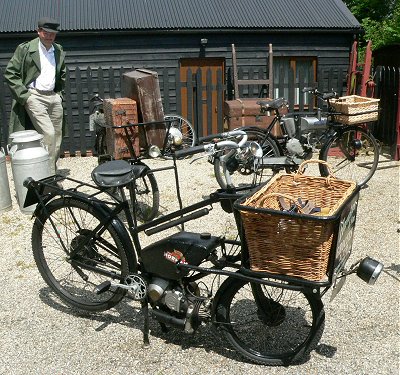
As a commercial vehicle, the deep, flat, droning exhaust note really suits the Norman Trade Carrier, roaring throatily while the rider thumbs open the throttle lever from low revs. The pace bike rider also commented on the powerful sounding tone. Despite being fitted with a back pedal brake mechanism, the rear stopper seemed to function no better than an average hand lever arrangement, while the front brake made little more than a feeble token effort towards slowing the lumbering beast! In common with most autocycles, the lights appear to only be fitted in an ornamental capacity.
Credit for production of the first trade carrier autocycle would appear to go to Cyc-Auto, as a passage in the 1938 Meat Trades Journal features a reference to ‘Pankhurst & Co of Merton Road, Southfields who have been using a pair of them for over two years’. This account would suggest Cyc-Auto versions being available in 1936 as C & D models replaced the original A & B type machines, and seemingly endorsed by an undated Iceni CAM archive leaflet illustrating a large-wheel ‘Tradesman’s Carrier Model E’ with the original Wallington Butt engine, which began to be succeeded by the Villiers engine in 1937. The James and Norman auto-carrier machines subsequently appeared in literature during 1939, and for 1940.
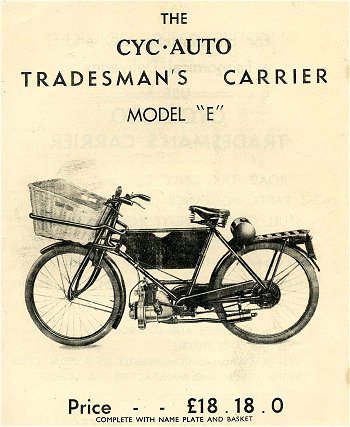
1936 Cyc-Auto carrier
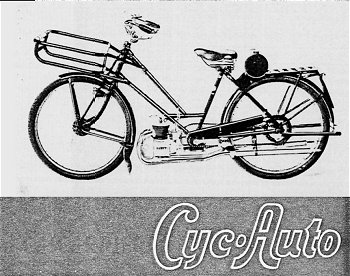
1951 Cyc-Auto carrier
Researches have so far failed to turn up evidence that any other makers offered motorised commercial autocycles, but a 1938 trade bike manufacturers list notably includes Aberdale, BSA, Coventry-Eagle, Dayton, James, New Hudson, New Imperial, Norman, Royal Enfield, Three Spires, and Triumph. Any of these firms would undoubtedly have been capable of producing an auto carrier, and a number of them certainly went on to build conventional autocycles.
While sequentially allocated James motor cycle serial numbers had only reached Model 20 by this time, the trade autocycle K54 (1939) designation seems to have appeared as a progression within their carrier cycle series. James carrier bicycle types were listed by specific model numbers: 41 Samson Carrier Bicycle, 42 Samson Low-Gravity Carrier, 43 Cob Carrier, 44 Duplex Carrier, 45 Open Front Carrier, 46 Sidecar Carrier, 47 & 47M Samson Carrier Tricycles, 48 Leader Carrier Tricycle, 49 Valet Carrier Tricycle, 50 Confectioners Carrier Tricycle, 51 Dairyman’s Carrier Tricycle. Again we find the L54 model number appearing against the Auto Carrier in a rare surviving original copy of a James 1940 listing leaflet.
Cyc-Auto returned to list carriers again after WWII, from 1949 up until the company finally faded away in the late 1950s.
Though trade carrier autocycles appeared in listings over several years, they were a very minor product. Classed as commercial vehicles, auto-carriers offered an incentive of exemption from purchase tax up to 1951, when the government closed that loophole.
In 1949 Cyc-Auto posted their Webb new girder fork ‘Superior’ model at £48-10s-0d plus £13-1s-11d purchase tax, making £61-11s-11d total, while at the same time, their rigid fork ‘Carrier’ was being offered at only £52-0s-0d.
Operating an auto-carrier would also have qualified under the Road and Rail Traffic Act of 1933, and required a ‘C’ class trade licence into the early 1960s. A ‘C-licence’ for carriage in connection with a trade or business (for shop deliveries) was valid for 5 years and required the display of a second disc, hence the dual licence holder.
Due to the low demand of these carrier autocycles, they wouldn’t be the sort of thing that any agents would be likely to hold in stock for people to walk in and buy off the showroom floor, they would almost certainly have only been built to specific customer order. Even in their own time, auto-carriers were exceptional oddities—in the 21st century they are an irresistible curiosity, and anyone with even no knowledge of what one of these vehicles is, will certainly still appreciate they are looking at a most extraordinary machine.
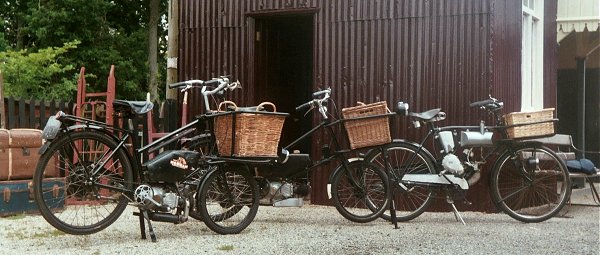
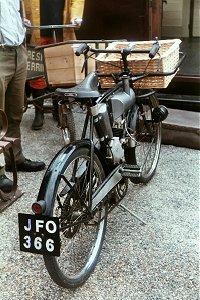
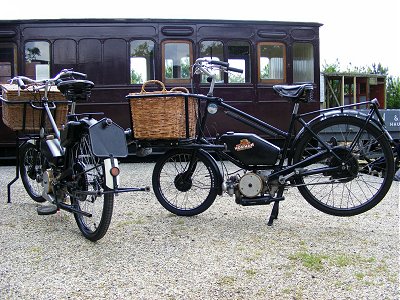
A last look at our three Trade Autocycles
We hear a brass band playing down in the park by the river, and our auto-carriers head off that way, pursued by an assorted regiment of tradesman cycles, while we join the walking throngs of people making their way toward the music. Heavy weather suddenly closes above us, the skies darken, and a chill wind begins to nibble at our cheeks. We’ve seen this sign before! Somewhere close, a portal is about to open. Ahead of us, a spiralling column of cloud drops from the air and touches ground amid a maelstrom of whirling leaves. This may be our only chance to escape this strange trade-carrier dimension. Everyone else has fled, but we run across the park toward the vortex—and hurl ourselves into the void … Pandamonium!
This article appeared in the October 2008 Iceni CAM
Magazine.
[Text © 2008 M Daniels.
Original photos © 2008 M Daniels and A Pattle
(except ‘Bonsey’ autocycle photo © 1990
A Pattle). Period documents and pictures from IceniCAM Information Service.]
With thanks to the Mid-Suffolk
Light Railway Museum, where most of the photographs were
taken.
Publication of In the Trade in IceniCAM was one of those giant landmark features that absolutely had to be done—but what an epic! Despite the appeal of the remarkable subject matter, nobody has produced anything on Trade Carrier Autocycles ever before—maybe because they were such a minor product, so rare and obscure, though more probably because it would be so incredibly difficult to find enough material to produce an article. With absolutely no basis to start from, every tiny period reference had to be painstakingly tracked down, to build up the jigsaw, and when you’re starting from scratch to hunt down material up to 70 years old, that’s not research—that’s archaeology.
It’s hard to put a firm date on exactly when the Trade Carrier project started, but it certainly feels like many years ago when owner Luke Booth brought the first decrepit parts of the Levules up for engineering. It proved to be a long job, and many interested parties watched the pieces passing in and out of the workshop as the machine slowly evolved through progressive phases of reconstruction. With restoration finally completed around 2005 and the autocycle appearing at events along the south coast, it created quite a stir wherever it turned up. However, good intentions to develop an article on the Levules around this time were thwarted by the idiot committee of the NACC deciding that its members no longer wanted to read feature articles!
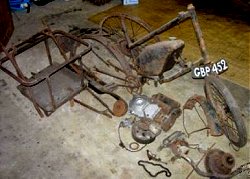
The Norman Trade Carrier
‘as found’
Paul Nelmes subsequently salvaged the appallingly corroded remains of the Norman Trade Carrier early in Spring 2006, miraculously returning it to a working machine in a matter of mere weeks, to campaign it on the rally circuit over the following season. Again, the prospect of ever getting a feature out to the true enthusiasts of these machines around this time remained pretty hopeless.
Only in April 2007 did prospects for presenting articles dramatically improve with launch of the new Iceni CAM Magazine, so research and collation to assemble a trade carriers article could finally begin, at which point the mountain to climb just got a whole lot bigger as the monstrous James Auto-Carrier commenced reconstruction and became added to the equation.
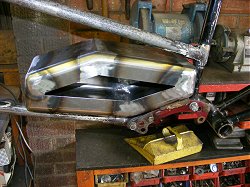
Reconstructing the
James’s fuel tank
Another year on, and the ‘period set’ photoshoot was booked to get all the carriers together for Sunday June 15th at the Mid-Suffolk Light Railway halfway stop on the Horham Run, though at the end of April the James was still no more than a pile of pieces—with a lot of bits missing! Against all odds, frantic efforts just about managed to deliver the machine in time for the photoshoot, and only restricted pictures and information of the trade carriers were released from the Horham Run in the photographs posted on IceniCAM website, to maintain an element of surprise prior to the article’s release.
Presenting the finished article only became possible by the many hundreds of hours recovering all three of these unique machines from utter ruins, and some of the most exhaustive research efforts the team has undertaken. Though the amount of work required to produce In the Trade was way off the scale, getting down to basic numbers, the actual cost directly attributable to making the article was remarkably small, only some £15 in film, processing and CD, and maybe some token addition for fuel.
Devon member of the East Anglian Cyclemotor Club, Peter Vaughan picked up the sponsorship credit on the trade article, saying association with honest working utility machines really appealed to him.
It quickly became apparent that In the Trade was developing into a vast production, and realisation that the printed magazine would never have the capacity to present all the associated pictures we would like to include with the article. This led to many painful decisions in editing, as the feature had completely outgrown its medium. So it was that In the Trade became our first mega-article, written primarily for the IceniCAM website Director’s Cut version, which was the only way the complete package as intended, could ever be presented.
| CAMmag Home Page | List of articles |